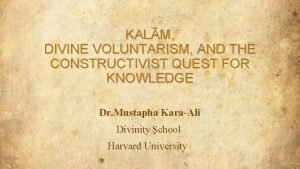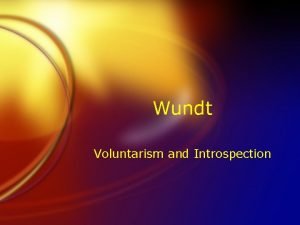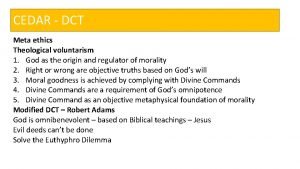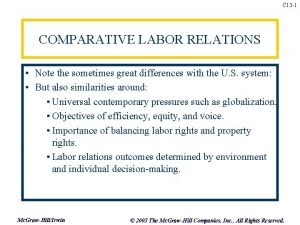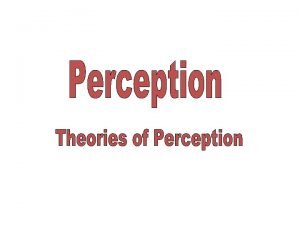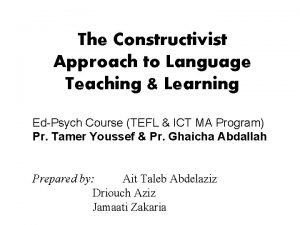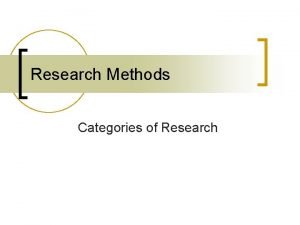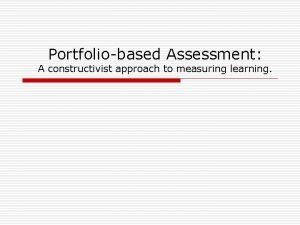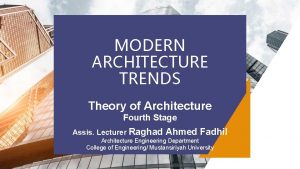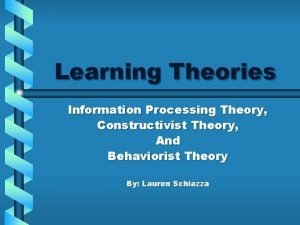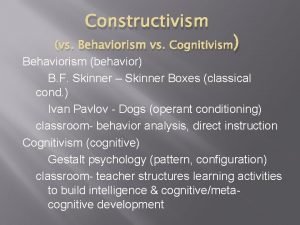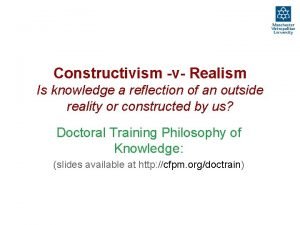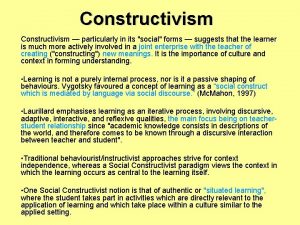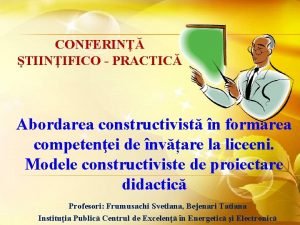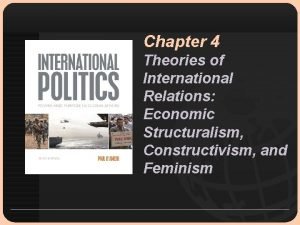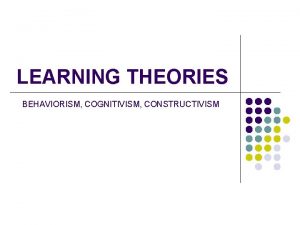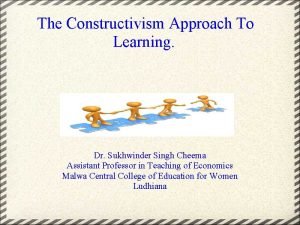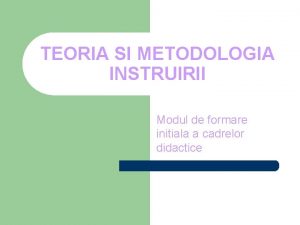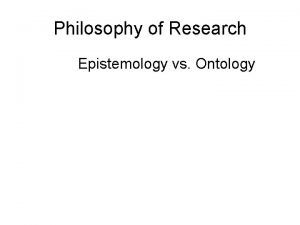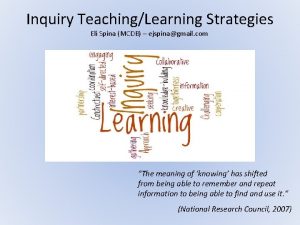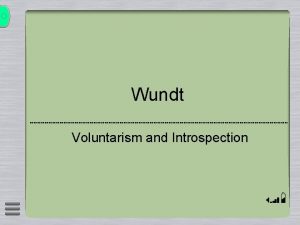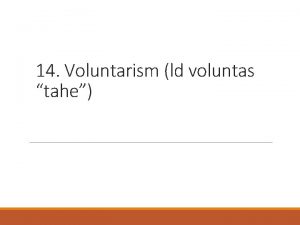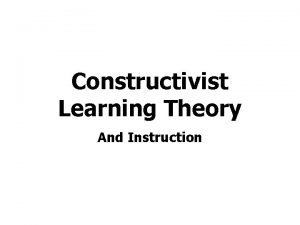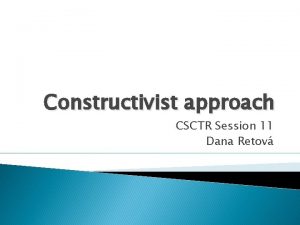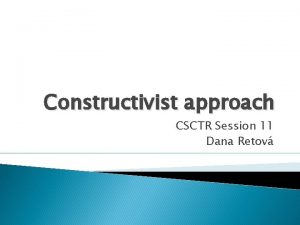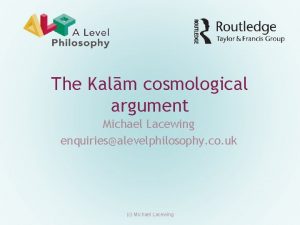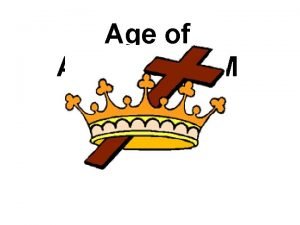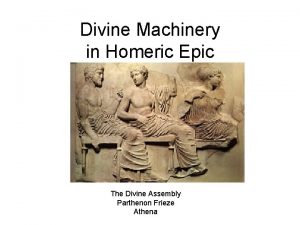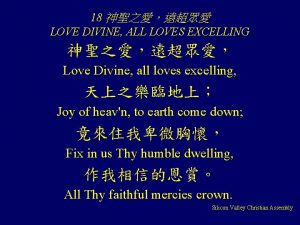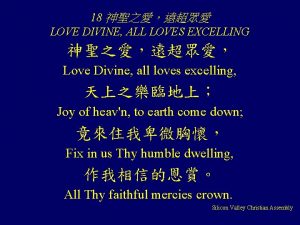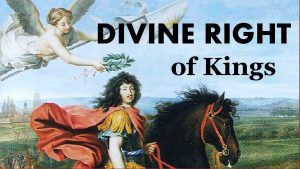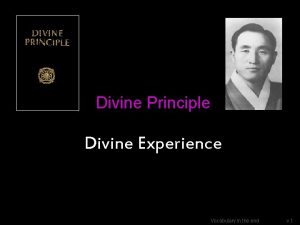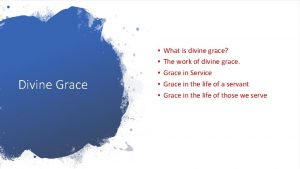KALM DIVINE VOLUNTARISM AND THE CONSTRUCTIVIST QUEST FOR






































- Slides: 38

KALĀM, DIVINE VOLUNTARISM, AND THE CONSTRUCTIVIST QUEST FOR KNOWLEDGE Dr Mustapha Kara-Ali Divinity School Harvard University

INTRODUCTION • A prophetic miracle is an event that can take place without causing an overhaul of a constructivist framework for science. • Developed in kalám in the fifteenth century and in particular in Ottoman Constantinople. • The definition of the prophetic miracle within the discourse of kal ám is “an event that breaks an observable habit in nature in support of one who is claiming prophethood ”. • Contrast to Aristotelian necessitarian realism, as carried by their opponents the Greek minded falasifah, and which was rejected by these kal ám scholars as it faces an epistemic breakdown with the possibility of the miracle.

1. Kalám, astronomy and the Copernican Revolution 2. Realism and the miracle: The epistemic challenge 3. Kalá m and the miracle: Contingency versus necessitarianism 4. Constructivist epistemology: Qushji and the Resolution Scientific 5. Divine voluntarist theology: Unitarianism in history

`ALI QUSHJI (D. 1474) • `Ali Qushji (born Samarkand ~1400) • Mathematician , astronomer, epistemologist, semanticist and a kal ám scholar • Invited by Sultan Mehmed II to Constantinople (~1470) • Died Constantinople (1474 ) Portrayed (right): Qushji handing a copy of his mathematics book al-Fathiyyah to Sultan Mehmed II (~1471)

REGIOMONTANUS (D. 1476) • Johannes Muller von Konigsberg (b. 1436) • Wrote the Epitome of Almagest 1496) (Venice, • Commissioned by Bessarion (Cardinal at Constantinople 1460’s)

REGIOMONTANUS AND COPERNICUS Noel Swerdlow (University of Chicago): “Copernicus’s derivation of this theory rests upon the eccentric model of the second anomaly and therefore upon [the] two propositions in the Epitome. In this way, Regiomontanus provided the foundations of Copernicus’s great discovery. It is even possible that, had Regiomontanus not written his detailed description of the eccentric model, Copernicus would never have developed the heliocentric theory” (1973).

COPERNICUS (D. 1543) • Nicolaus Copernicus (Polish: Mikołaj Kopernik) • Renaissance astronomer mathematician and • Studied in Venice (University of Padua)

QUSHJI AND REGIOMONTANUS “The Eccentric Model for the Second Anomaly of the Lower Planets” Left: Qushji’s treatise, (Suleimaniyyah Library Istanbul, ~1430) Right: Regiomontanus, Epitome of Almagest (Venice, 1496) F. Jamil Ragep, “`Ali Qushji and Regiomontanus: Eccentric Transformations and Copernican Revolutions”, Journal of the History of Astronomy , vol. 36, no. 4 (2005), 359 -371

VENICE-OTTOMAN RELATIONS • Venice traded in Ottoman Middle East • Venetian Renaissance favorable to Ottoman art • Venice excommunicated twice by Vatican for relations with Ottomans • Copernicus studied at University of Padua (Venice) Only portrait of Sultan Mehmed II (r. 1451 -1481 ) By Gentile Bellini (1480) - lived in Sultan Fatih Court in Constantinople (1478 -1481)

GENTILE BELLINI (1480) Portrait of Cem Sultan (Fatih’s son)

ANDREA MANTEGNA (1495)

GIOVANNI MANSUETI (1485)

GIORGIONE (1506) “The Three Philosophers”

1. Kalá m , astronomy and the Copernican Revolution 2. Realism and the miracle: The epistemic challenge 3. Kalá m and the miracle: Contingency versus necessitarianism 4. Constructivist epistemology: Qushji and the Resolution Scientific 5. Divine voluntarist theology: Unitarianism in history

REALISM AND THE MIRACLE: THE EPISTEMIC CHALLENGE • Realist epistemology of the Greeks assumes knowledge mind, based on necessitarian causal logic and modality. is independent of the human • Realism considers a priori knowledge is universal which means “this knowledge deemed universal - will always be true for every future event one encounters ”. • This view of a priori eliminates the idea of possible denied. worlds. Miracle subsequently • Under realism, the possibility of the miracle collapses its idea of necessitarian “laws of nature”. the epistemic system based on

1. Kalám, astronomy and the Copernican Revolution 2. Realism and the miracle: The epistemic challenge 3. Kalám and the miracle: Contingency versus necessitarianism 4. Constructivist epistemology: Qushji and the Resolution Scientific 5. Divine voluntarist theology: Unitarianism in history

KALÁM ANDTHE MIRACLE: CONTINGENCY VERSUS NECESSITARIANISM • While refuting necessitarian causality, the Kalám scholar was seeking an alternative methodology to secure the place of natural science. • A quest of Kalám was to provide an alternative epistemology for human understanding based on the Unitarian theology of God’s Omnipotence and Voluntarism. • The mutakallim considered that logic is derived from language and not vice versa. • Modified the foundations of Avicennan logic (as he represented the Greek falsafa side of necessitarianism). • The ‘Problem of induction’ within the Aristotelian framework - speculative framework.

KALÁM ANDTHE MIRACLE: CONTINGENCY VERSUS NECESSITARIANISM • Semantics, semiotics and philology - the rationale behind the development in the fourteenth century of the new discipline of `ilm al-wad` (science of positing meanings for expressions) based on the mental existence of concepts of human understanding. • Contingent modality of nature • Certainty of knowledge outside necessitarian causality. • The idea of a “law” of nature is opposed without the need to give up on the idea of a “concept” in nature as a basis for the a priori knowledge. The necessity of a priori knowledge considered to be in relation to the human will as an obligatory cognitive process. • Necessity considered to be an `ilm daruri. internal necessity of knowledge or what they called

1. Kalám, astronomy and the Copernican 2. Realism and the miracle: The epistemic Revolution challenge 3. Kalám and the miracle: Contingency versus necessitarianism 4. Constructivist epistemology: Qushji and the Scientific Resolution 5. Divine voluntarist theology: Unitarianism in history

SAMARKAND (15 TH CENTURY)

SAMARKAND OBSERVATORY (1420 -1449)

AYASOPHIA COLLEGE CONSTANTINOPLE (EST. 1470) • Qushji assumed the Professorship Chair in Astronomy and Mathematics at the madrasa or college of Ayasophia

SHARH TAJRID AL-KALÁM(~1450) OXFORD (BODLEIAN LIBRARY)

SHARH TAJRID AL-KALÁM (~1450) HARVARD (WIDENER LIBRARY)

CONSTRUCTIVIST EPISTEMOLOGY: QUSHJI AND THE SCIENTIFIC RESOLUTION • Unravel new conceptual structure of astronomy according to constructivism of Kalám. • Qushji, one of the greatest epistemologists and mathematicians • Qushji redefines the meaning of a priori knowledge from the Greek realist understanding.

CONSTRUCTIVIST EPISTEMOLOGY: QUSHJI AND THE SCIENTIFIC RESOLUTION • Kalám for Qushji is not “speculative theology” but a kind of “theology in practice” which develops and applies an epistemology as a synthesis between the mind and the senses • Qushji magnum opus on Kalám an encyclopaedic endeavour (physics, optics, motion, astronomy, politics, semantics, etc. ). • Qushji’s epistemology is a constructivist theory of knowledge founded upon the “empirical a priori”.

CONSTRUCTIVIST EPISTEMOLOGY: QUSHJI AND THE SCIENTIFIC RESOLUTION • Concepts and names are the basic entities of human understanding • Concepts are learnt through repeated observations within a social context. • Concepts not applied to all possible worlds, rather knowledge of the actual world is constructed from the learnt concepts during the process of perception, • Active mind instantiates what is considered to be a priori knowledge based on the learnt concepts.

CONSTRUCTIVIST EPISTEMOLOGY: QUSHJI AND THE SCIENTIFIC RESOLUTION • Constructive epistemology is based on the idea that knowledge is due to a cognitive process in the mind and not a theory of correspondence. • People acquire the causal concept that relates cause and effect so that when faced with a new empirical experience, the learnt relational concept allows one to form a causal expectation. • Expectation broken when a prophetic miracle occurs • One attains a priori knowledge of the empirical event contradistinction to the learnt habitual occurrence in

CONSTRUCTIVIST EPISTEMOLOGY: QUSHJI AND THE SCIENTIFIC RESOLUTION • Quasi-realists cannot claim that constructivist experience is irrational, as their argument about a modal impossibility is metaphysical not empirical. • The idea of kharq lil-`adah or extra-habitual occurrence in nature deals with the established in the mind, i. e. the habit, • No break of a “natural law” (idea of natural law under constructivism incoherent - not the basis for scientific knowledge).

CONSTRUCTIVIST EPISTEMOLOGY: QUSHJI AND THE SCIENTIFIC RESOLUTION • In Kalám, God does in His dominion what He wills and there are no laws incumbent upon God as a matter of necessity. • Under the constructivist Kalám scheme , the prophetic miracle, which is the “work” of a prophet associated with a claim to prophethood, is an event that does not change the mentally learnt causal concepts of nature. • Miracle received as a sign for “wonder” for its nonhabitual occurrence.

CONSTRUCTIVIST EPISTEMOLOGY: QUSHJI AND THE SCIENTIFIC RESOLUTION • Under habitual break man receives the a priori knowledge (instantaneous) that the specific claim to prophethood is true. • Either wilfully acquires this a priori knowledge ( kasbi) or not. • Implications for man’s free will • Constructivism in Kalám not pure relativism or instrumentalism.

CONSTRUCTIVIST EPISTEMOLOGY: QUSHJI AND THE SCIENTIFIC RESOLUTION • Prophetic miracle epistemologically scientific (in similar to knowledge of unseen Earth motion Kalám) – • Earth motion rejected before development of a constructivist justification in fifteenth century. • Copernicus (mathematician) did defend Earth’s motion not epistemologically • Qushji provided the constructivist foundations for Earth’s motion • Regiomontanus conveyed it with no commentary (commissioned by Bessarion, Cardinal in Ottoman Constantinople in the 1460’s).

1. Kalám, astronomy and the Copernican Revolution 2. Realism and the miracle: The epistemic challenge 3. Kalám and the miracle: Contingency versus necessitarianism 4. Constructivist epistemology: Qushji and the Resolution Scientific 5. Divine voluntarist theology: Unitarianism in history

DIVINE VOLUNTARIST THEOLOGY: UNITARIANISMIN HISTORY • Relationship between science and religion (theological positions): • 1. Voluntarist theology : Came to the fore in Kalám theology with the notion of God being Omnipotent. • 2. Intellectualist theology : Attitudes closer to Plato and Aristotle (realist) – considers God has to conform to various forms (rejected by Unitarian theology) • Unitarian theology rejects the divisibility of God’s eternal attributes.

DIVINE VOLUNTARIST THEOLOGY: UNITARIANISMIN HISTORY • Theology of divine voluntarism drops metaphysical necessity of nature. • Voluntarist theology holds that God can do what He wills when He wills. • For voluntarists only way to discover how the world is - examine it closely. • Kalám scholars, instead of “laws of nature” as essentialist modality, had “concepts of the mind” as a learnt regularity • Contingent worldview allows for miracle while allowing for mathematical certitude for empirical a priori knowledge.

DIVINE VOLUNTARIST THEOLOGY: UNITARIANISMIN HISTORY • Contrary to Unitarian/Voluntarist/constructivist formulation we have interventionist account of divine action. • Interventionism says, “If God is the creator of the laws of nature, then he can intervene. He can interrupt or override the laws so as to perform special divine acts”. • Miracles defined by interventionists as violations of the laws of nature. • Interventionist accounts criticized for variety of reasons: 1. It contradicts notion of realist natural law to consider it violated. 2. It compromises the scientific method and scientific certitude 3. It seemingly reduces God’s action within all the created order .

DIVINE VOLUNTARIST THEOLOGY: UNITARIANISMIN HISTORY • Unitarian theology gave intellectual frame for constructivist epistemology. • Constructivism historically associated with revolutionary practice of mathematical astronomy. • Kalám experience considered (at least) a parallel development to Scientific Revolution in Europe.

 Divine voluntarism
Divine voluntarism Nnn kalm pro
Nnn kalm pro Voluntarism wilhelm wundt
Voluntarism wilhelm wundt Is/ought distinction
Is/ought distinction Voluntarism apush
Voluntarism apush Schools of psychology structuralism
Schools of psychology structuralism Gregorys constructivist theory
Gregorys constructivist theory Constructivist implications
Constructivist implications Research objectives sample
Research objectives sample Constructivist assessment examples
Constructivist assessment examples Constructivist architecture characteristics
Constructivist architecture characteristics Constructivist theory
Constructivist theory Social constructivist meaning
Social constructivist meaning Constructivism vs behaviorism vs cognitivism
Constructivism vs behaviorism vs cognitivism Constructivism vs realism
Constructivism vs realism Social constructivism
Social constructivism Profesorul constructivist
Profesorul constructivist Structuralism and constructivism
Structuralism and constructivism Jonassen constructivism
Jonassen constructivism Cognitivist theory
Cognitivist theory Kathy charmaz constructivist grounded theory
Kathy charmaz constructivist grounded theory What is constructivist
What is constructivist Modelul constructivist al invatarii
Modelul constructivist al invatarii Ontology in research
Ontology in research Constructivist etymology
Constructivist etymology Kontinuitetshantering i praktiken
Kontinuitetshantering i praktiken Typiska drag för en novell
Typiska drag för en novell Tack för att ni lyssnade bild
Tack för att ni lyssnade bild Vad står k.r.å.k.a.n för
Vad står k.r.å.k.a.n för Varför kallas perioden 1918-1939 för mellankrigstiden?
Varför kallas perioden 1918-1939 för mellankrigstiden? En lathund för arbete med kontinuitetshantering
En lathund för arbete med kontinuitetshantering Adressändring ideell förening
Adressändring ideell förening Personlig tidbok
Personlig tidbok Sura för anatom
Sura för anatom Förklara densitet för barn
Förklara densitet för barn Datorkunskap för nybörjare
Datorkunskap för nybörjare Boverket ka
Boverket ka Att skriva en debattartikel
Att skriva en debattartikel Delegerande ledarstil
Delegerande ledarstil
